Abstract
Low-level coastal jets are a common climatic phenomenon along much of the coast of Tenerife. However, there are large differences in intensity and frequency between the northern and southeastern facades of the island, even though both are exposed to the trade winds. This study analyzes how a local factor, such as the existing vegetation cover, influences this phenomenon. Comparing the wind records and the Normalized Difference Vegetation Index of both exposed facades, it is observed that the lower the values of this index of vegetation cover, the greater the increase in the mean diurnal wind speed. It can be stated, from nine years of study, that there are clear indications of a relationship between the vegetation index used and the low-level coastal jet intensity.
1. Introduction
1.1. Aim of the Research
A low-level coastal jet (LLCJ) is defined as a baroclinic and mesoscale structure in the lower troposphere, caused by the large pressure difference between a sea and land area. These LLCJs are confined within a marine atmospheric boundary layer, producing wind parallel to the coast [1]. The intensity of these winds is usually noticeable during daylight hours from mid-morning onwards on important stretches of the Canarian shoreline.
These jets play a crucial role in local meteorology, oceanography, and climatology, influencing coastal ecosystems, weather patterns, wave climate, and therefore human activities such as navigation, aviation, agriculture, and renewable energy production.
The present study investigates the relationship between the existing vegetation cover on the islands and the intensity of the coastal jets. For this purpose, this paper will focus on the island of Tenerife, the highest volcanic edifice in the Canary Archipelago. With its roughly triangular shape, two of its faces are exposed to trade winds. However, the behavior of these winds differs significantly on each face. A substantial corpus of literature exists on the relationship between wind speed and the vegetation; for instance, see [2,3,4]. The novelty of this work lies in its analysis of the influence of vegetation on LLCJs, with a particular focus on the role of vegetation in shaping wind patterns, rather than the conventional view of wind influencing vegetation.
1.2. General Characteristics of Low-Level Coastal Jets
LLCJs typically result from the interaction between synoptic-scale pressure systems, local orography, and differential heating between land and ocean [5]. The presence of a thermal inversion and a stable marine boundary layer (MBL) is a common feature in their development [6]. Upwelling is an important factor in the formation of LLCJs, as water cools the air above it, thereby increasing the temperature gradient that drives the wind jet. These jets exhibit a pronounced diurnal cycle, with maximum intensities generally observed in the afternoon and early evening [7].
LLCJs have been observed in numerous regions across the globe, including the west coasts of both North and South America, the Iberian Peninsula, North Africa, the Arabian Sea, and the coasts of Australia and Japan. The west coast of North America has been particularly notable in terms of research focus, with studies conducted there being among the earliest in the field [8,9].
1.3. Influence of Vegetation on Land Temperature
The relationship between vegetation and environmental temperature has been the focus of extensive research due to its implications for climate change mitigation and microclimate regulation [10]. Urban environments characteristically exhibit elevated temperatures in comparison to adjacent rural areas, a phenomenon attributable to the concentration of buildings and the absence of substantial foliage. However, the presence of green spaces, such as parks and densely vegetated areas, has been observed to result in the occurrence of an ‘urban cold island’ effect, wherein cooler temperatures are recorded within these urban enclaves [11]. In rural environments, vegetation plays a pivotal role in regulating soil and air temperature. The height and density of vegetation have been shown to significantly influence the variation of soil temperature, thereby reducing the daily thermal amplitude and favoring moisture retention [12]. In addition, on the coastal strip, the interplay between vegetation and the surrounding environment is highly influential. It affects sand retention, acts as a wind attenuation filter and protects against erosion by fixing the substrate.
2. Materials and Methods
2.1. The Canary Islands, Environmental Conditions
The Canary Archipelago, a group of islands of volcanic origin, is in the North Atlantic Ocean at a latitude of 27° to 29° north and a longitude of 13° to 18° west (Figure 1). The archipelago comprises seven major islands, four minor islands, and numerous rocks. It is situated approximately 100 km from the West African coast.
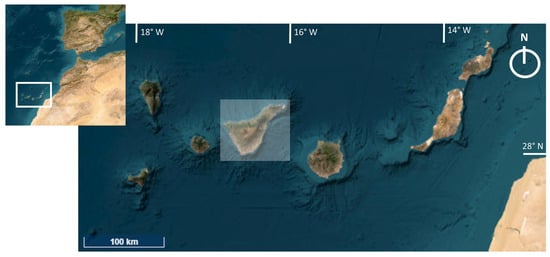
Figure 1.
The Canary Islands, located off the northwest coast of Africa. The island of Tenerife has been highlighted.
With a total area of 7446 km2, the Canary Islands are characterized by a diverse topography, encompassing a variety of geographical features, including shield volcanoes and deeply incised valleys. Tenerife is one of the highest oceanic islands worldwide, crowned by the stratovolcano Teide. While La Palma and El Hierro are distinguished by their steep, rugged terrains, formed by recent volcanic activity [13], older islands such as Fuerteventura and Lanzarote display lower reliefs due to prolonged erosion [14].
The Canaries are distinguished by a subtropical climate, characterized by consistently mild temperatures throughout the year. This climatic stability is attributed to the influence of the Azores High, which maintains a relatively constant temperature range between 18 °C and 24 °C [14]. Despite their subtropical latitude, the islands benefit from the moderating effect of the northeast trade winds and the Canary Current, which temper extreme heat [15]. The Canary Islands frequently experience Saharan dust intrusions events (locally known as “calima”), which are episodes of airborne dust transported from the Sahara Desert. These events occur when strong easterly winds carry fine mineral dust particles across the Atlantic, leading to a significant reduction in visibility and a rise in particulate matter concentration [16].
The vegetation of the Canary Islands is typically organized into distinct altitudinal zones, each characterized by specific plant communities adapted to the prevailing environmental conditions [17], and exhibits significant differences between north- and south-facing slopes, primarily due to the influence of the trade winds [18]. The altitudinal distribution of vegetation was already observed by the wise scientist Alexander von Humboldt during the days he spent in the island of Tenerife in 1799 [19], and he left it documented in the famous drawing entitled Tableau physique des Iles Canaries. Géographie des Plantes du Pic de Tenerife [20].
The endemicity of flora in the Canary Islands is very remarkable [21]. It is not possible to provide a concise summary of the botanical richness of the coastal area of these islands in a few lines. As a preliminary overview, it can be stated that in the lower altitudes of the island, xerophytic vegetation is abundant, with the rocky coast being dominated in many cases by tabaiba dulce (Euphorbia balsamifera). In dune areas, the presence of shrubby plants such as tarajales (Tamarix canariensis) has been observed. Canary palm trees (Phoenix canariensis) are a common observation at the bottoms of ravines. At a slightly higher altitude, communities of tabaibas begin to appear, dominated by cardones (Euphorbia canariensis). A number of other endemic plants are identified in these communities, including cerrajas (Sonchus spp.), magarzas (Argyranthemum spp.), or bejeques (Aeonium spp.) [22].
Forty percent of the area of the archipelago is under some form of environmental protection. This protected area is spread over all the islands, in different ecosystems and climatic and altitudinal levels [23].
In relation to agriculture, less than 6% of the surface area of the islands is in production, and approximately two thirds of this area is irrigated farming [24]. Many of the agricultural fields are not cultivated. There has been an evident decrease in agricultural areas in the last three decades [25]. Bananas are the most important crop, covering almost 4500 hectares. Other important crops are flowers, potatoes, vineyards, and tropical fruits [26].
Returning to coastal jets, the following elements are required for an LLCJ to occur [1]:
- A wet and stable MBL as a result of upwelling;
- The presence of a persistent thermal inversion;
- An orographic barrier close to the coast, which is also subject to drastic diurnal thermal variations due to high insolation;
- Dynamic and orographic local regulators, which act on near-surface wind intensity.
The presence of all these elements is observed in the Canary Islands, and of course, on the island with the highest altitude, Tenerife, with a total height of 3715 m and a surface area of 2034 km2.
2.2. The Study Area of Tenerife
As already mentioned in the introduction, this island has two of its faces exposed to the trade winds, the north and southeast sides. Figure 2 shows both faces, as well as cross-sectional profiles of the island.

Figure 2.
The island of Tenerife. The northern side (blue line) and the southeastern side (red line) are exposed to the trade winds. The height of each profile is indicated in meters, with the red horizontal line denoting the average height of that profile (profiles obtained through the application of the IDE Canarias. https://visor.grafcan.es/visorweb/ (accessed on 22 March 2025).
In order to undertake this research, the two zones of Tenerife Island under consideration were defined in terms of prominent coastal features. Specifically, the northern facade under scrutiny (illustrated by the blue line in Figure 2) is delineated by Punta de Teno (the westernmost point of the island) and Punta de Taganana, situated at the northeastern extremity. The southeastern facade (red line in Figure 2) is delineated by Punta de Rasca (the southernmost point of the island) and Punta de Antequera, at the northeastern end of the coastline.
With respect to the altitude limitation, the area between the coast and 600 m above sea level has been the subject of this detailed study. It is important to note the increased risk of exceeding the altitude of the thermal inversion in the summer months when ascending to higher elevations.
The season under study was summer, a time of year when trade winds are known to be more intense and persistent [27]. This analysis covers nine years of data. Specifically, this research was conducted during the summers of 2016 to 2024.
The present research involves two primary categories of data: wind records (speed and direction) from the SIAR meteorological stations (depending on the Spanish Ministry of Agriculture) located in the areas under study and vegetation cover records, thanks to the Normalized Difference Vegetation Index (NDVI) values. A detailed discussion of both data categories is provided below.
2.3. Wind Records
On the island, there is a dense network of agro-climatic stations depending on different administrations and public organizations, both insular (The Council of Tenerife), regional (Government of the Canary Islands), and national (State Meteorological Agency, AEMET).
A good number of them are part of the national SIAR system, which depends on the Ministry of Agriculture, Fishing, and Food. The primary function of this network is to obtain the necessary parameters to determine the irrigation requirements representative of the area in which it is located. These parameters encompass wind speed and direction, which are gauged by means of a wind sensor, the calibration of which is periodically verified [28].
Data from a total of 24 stations were used, with records taken every 30 min. Fifteen of these were located on the north facade and the remaining nine were on the south facade (Figure 3). The altitudes at which these agro-meteorological stations are located range from 17 to 559 m above sea level. Unfortunately, it was not always possible to obtain data from all these stations for the 9 years of this study.
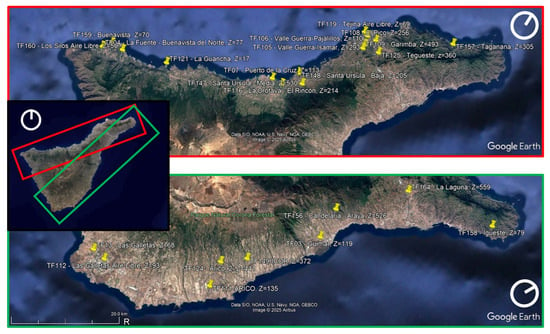
Figure 3.
Agro-meteorological stations on the north (top image) and south (bottom image) facades. The altitude at which the station is located is indicated next to its name.
It is a well-established fact that trade winds exhibit a high degree of constancy in their direction of origin, emanating from the first quadrant (typically with orientations ranging from north-northeast to east-northeast). For the preliminary filtration of the measurements obtained from the wind sensors at the stations, the range of directions of provenance (Wdir) will be expanded to include all those with components north and east (0° < Wdir < 90°). It is to be considered that the network of stations utilized, designed, and operated primarily for agro-climatic purposes is situated at a relatively low altitude. Consequently, the observations made at these stations may be susceptible to local turbulence effects.
2.4. NDVI
The purpose of remote sensing is the identification and characterization of materials and processes at the earth’s surface by means of electromagnetic radiation emitted by the earth’s surface or reflected from the sun [29]. The study of vegetation cover for environmental and agronomic purposes has been the focus of attention of remote sensing specialists since its beginnings.
For this purpose, the satellite information delivered through a multiband image must be categorized and grouped. This can be achieved through the elaboration of indexes. The NDVI is the best known and most widely used for all types of applications. The main reason is its simplicity of calculation and use [30]. This index is obtained by a simple ratio between the NIR (near infrared) and R (red) bands, with a value between −1 and 1:
Negative values of NDVI will be associated with flooded areas. Within the positive values, which are the ones of interest for this work, the higher the value, the higher the vegetation density.
A substantial number of studies have been conducted thus far that establish a correlation between this index and temperature, for instance, [31,32,33].
In this case, for the analysis using this index, Sentinel-2 L1C satellite imagery acquired during the summer of each study year was employed (Figure 4). The images have a resolution of 100 m/pixel, which is a downsampling of the 10 m/pixel originals. The information has been obtained from the European Copernicus database. The National Geographic Institute (IGN) has publications that address the use of Copernicus in this type of monitoring [34]. Amongst the available images, those exhibiting minimal cloud systems that could distort results were selected.

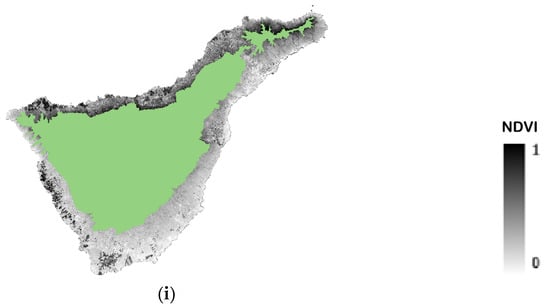
Figure 4.
NDVI of the coastal strip (0 to 600 m above sea level) of Tenerife. Based on Copernicus Sentinel-2 L1C images from (a) 19 July 2016, (b) 9 August 2017, (c) 30 July 2018, (d) 25 July 2019, (e) 19 July 2020, (f) 14 July 2021, (g) 14 July 2022, (h) 29 June 2023, and (i) 18 July 2024. Negative values were replaced with ‘no data’. Area higher than 600 m above sea level shaded in green.
To derive NDVI from Copernicus data, the B4 (red) and B8 (near-infrared) bands were downloaded from the orthoimages with a resolution of 10 m/pixel. Using the Raster Calculator tool in the QGIS software package (QGIS Desktop 3.36.1—Maidenhead version), the NDVI layer was obtained through the following operation:
Subsequently, negative values were truncated by replacing them with ‘no data’. The NDVI layer was resampled to a resolution of 100 m/pixel and clipped to the elevation range between 0 and 600 m.
Nevertheless, the Copernicus Browser tool allows direct download of raster layers with NDVI displayed in a color range from ochre/sand to dark green, enabling calculation validation. However, in this study, NDVI was represented in grayscale tones ranging from white (NDVI = 0) to black (NDVI = 1).
The orthoimages used correspond to some date between 29 June and 9 August for each year in the considered series, featuring minimal to no cloud cover over the 0–600 m elevation range. This selection aimed to avoid cloud cover effects on NDVI calculations.
3. Results
This section is divided into three subheadings. The initial part describes the analysis of the wind data from the stations used, the second part shows the values obtained for the NDVI, and finally the relationship between the two is analyzed.
3.1. Wind Data
This analysis employed data collected during the boreal summer months, corresponding to the annual maximum in both intensity and frequency of trade winds as established in Section 2. Specifically, statistical analysis has been carried out for the months of June, July, August, and September. The study years align with the vegetation index data (2016–2024). This approach enabled a direct comparison between wind data and NDVI values from the same annual period.
For every station under consideration and every year of study, three average speeds have been computed:
- Wads: the whole-day average speed in the period 1 June to 30 September;
- Ws9-21: the average speed in the interval between 9:00 a.m. and 9:00 p.m., when the effects of solar radiation on temperature are most apparent;
- Ws21-9: the average speed in the interval between 9:00 p.m. and 9:00 a.m., which is typically the coldest part of the day, and with a decrease in wind speed values.
To compute these average velocities, the proportion of records that have passed the directional filter (discussed in Section 2.3) at each station was considered (weighted average, regarding the load of each station’s records). The values obtained for each facade are shown below (Table 1 for the north facade and Table 2 for the southeast facade).

Table 1.
The mean wind velocity (m/s) for the months June, July, August, and September at the northern facade.

Table 2.
The mean wind velocity (m/s) for the months June, July, August, and September at the southeastern facade.
3.2. NDVI Calculations
The NDVI values for the two facades under study have been calculated from the images shown in Figure 4. The obtained values (Table 3) show that both facades exhibit value spectra spanning from zero to near-unity values. The northern facade demonstrates significantly higher mean values.

Table 3.
Main statistical values of NDVI for north and southeast facades.
3.3. Relationship Between Wind Values and Vegetation Index
As previously discussed in Section 1.3, vegetation cover plays an important role in the diurnal temperature amplitude, which, as indicated in Section 1.2, is a determining factor in the intensity of coastal jets by increasing the temperature gradient between the sea and the land surface of the coastline.
NDVI values, the mean diurnal and nocturnal wind velocities, and the relation between diurnal and nocturnal speed for each facade and year are presented in Table 4. When plotting the NDVI–velocity pairs, it becomes clear that for daytime wind speeds, the values of each facade are grouped together (Figure 5a). In contrast, the division between the two facades is less apparent for the nighttime velocity values (Figure 5b). Finally, when NDVI values are plotted against the diurnal and nocturnal velocities ratio, it is clear that there is some correlation (Figure 6). The fit obtained with a second-degree polynomial function exceeds an R2 of 0.85. This function exhibits a lower bound of approximately 0.20 for the NDVI value.

Table 4.
NDVI value, Ws9-21, and Ws21-9 (m/s), and Ws9-21/ Ws21-9 ratio per year and side under study.
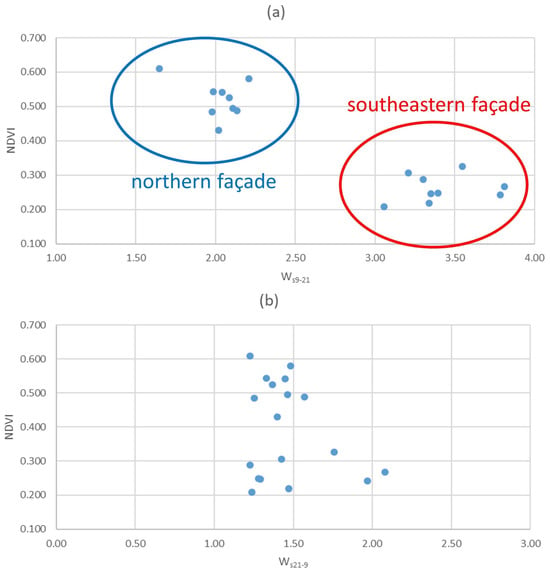
Figure 5.
NDVI vs. Ws9-21 (a) and NDVI vs. Ws21-9 (b).
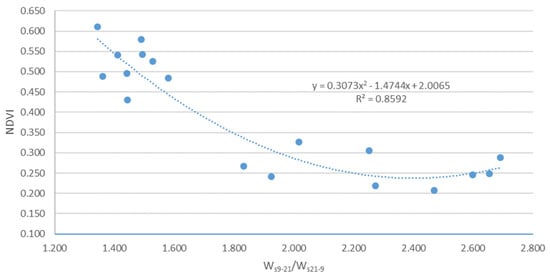
Figure 6.
NDVI vs. Ws9-21/Ws21-9 ratio.
4. Discussion
This work cannot be carried out without taking into account the difficulty of studying the balance between an ecosystem’s vegetation and its physical environment, a very complex subject where any simplification is unlikely to be successful.
Taking this difficulty into account, and in light of the tables and figures presented in Section 3, the following considerations can be made:
- The obtained NDVI values for each facade (Table 3) align with theoretical expectations: those corresponding to the northern facade are higher. The region’s topography, characterized by rugged orography, plays a pivotal role in the retention of humid winds [35], thereby establishing the optimal conditions for substantial vegetation growth in the north [17]. Conversely, on the southeast side, where the climate is warmer and drier, the ecosystem has adapted to these conditions, resulting in significantly lower NDVI values.
- Seasonal mean wind speeds (Table 1 and Table 2) fall within expected summer ranges for this maritime climate zone, consistent with documented human adaptations to these persistent environmental conditions. A comparison of the two facades reveals notable differences, with the southeast side exhibiting significantly higher wind speeds compared to the north side.
- As illustrated in Table 4, the increase in speed during the day is more pronounced on the southernmost facade. This facade is the one with the lowest NDVI.
- In the graphs corresponding to Figure 5, it can be seen how during daylight hours, the pairs of wind velocity–NDVI data are grouped according to the face to which they belong. In contrast, during the night, this distinction is not clear. For all the years under study, the averages of the diurnal records on the southern facade have been clearly higher. The differences in NDVI between both areas do not affect the mean nighttime wind speed, which is similar.
- While the years we studied are not sufficient to ensure statistical correlations of significance, Figure 6 indicates a relationship between lower NDVI values and greater increases in diurnal velocity with respect to nocturnal velocity. This will likely become more apparent as more years of study are added. This result is in agreement with the relationship between the existence of extensive vegetation cover and the difficulty of occurrence of LLCJs in the northern part of Tenerife, previously mentioned by the AEMET in the work already cited above [1].
- It should be reminded that since the records have been taken by agro-climatic stations, the situation and elevation of the anemometers with respect to the floor are not optimal for this type of study. Finally, this work has not taken into account the sea breeze circulation and the effect of its possible change of day–night breeze direction.
5. Conclusions
This analysis confirms that, for the study years, the lower the NDVI, the greater the increase in daytime wind speed from the first quadrant compared to that recorded during the night in the areas under study. This increase in daytime intensity is characteristic of low-level coastal jets.
Although the differences between the two facades are manifest in the analysis of data, further observations are needed to obtain sufficient significance to support this statement.
Author Contributions
Investigation, E.M. and M.G.-R.; Writing—original draft, E.M.; Writing—review and editing, M.G.-R. All authors have read and agreed to the published version of the manuscript.
Funding
This research received no external funding.
Institutional Review Board Statement
Not applicable.
Informed Consent Statement
Not applicable.
Data Availability Statement
All meteorological data used in this work have been provided by the Department of Irrigation, Natural Roads, and Rural Infrastructures (Spanish Ministry of Agriculture, Fishing, and Food). The data from satellite observations have been obtained in Copernicus, the Earth observation component of the European Union’s space program. For this purpose, the authors made the request in the website https://servicio.mapa.gob.es/websiar/ (accessed on 20 March 2025) and https://www.copernicus.eu/en/access-data (accessed on 6 June 2025).
Conflicts of Interest
Author Emilio Megías was employed by the company Satocan SA. The remaining authors declare that the research was conducted in the absence of any commercial or financial relationships that could be construed as a potential conflict of interest.
References
- Fernández Villares, J.; Fernández González, S. Jets Costeros En Gran Canaria y Tenerife. Caracterización y Mejora de La Predicción. Sexto Simp. Nac. Predicción Meml. Antonio Mestre 2019, 1, 223–240. [Google Scholar] [CrossRef]
- Hu, M.Q.; Mao, F.; Sun, H.; Hou, Y.Y. Study of Normalized Difference Vegetation Index Variation and Its Correlation with Climate Factors in the Three-River-Source Region. Int. J. Appl. Earth Obs. Geoinf. 2011, 13, 24–33. [Google Scholar] [CrossRef]
- Zhang, T.; Xu, X.; Jiang, H.; Qiao, S.; Guan, M.; Huang, Y.; Gong, R. Widespread Decline in Winds Promoted the Growth of Vegetation. Sci. Total Environ. 2022, 825, 153682. [Google Scholar] [CrossRef]
- Yu, M.; Wu, B.; Zeng, H.; Xing, Q.; Zhu, W. The Impacts of Vegetation and Meteorological Factors on Aerodynamic Roughness Length at Different Time Scales. Atmosphere 2018, 9, 149. [Google Scholar] [CrossRef]
- Luiz, E.W.; Fiedler, S. Global Climatology of Low-Level-Jets: Occurrence, Characteristics, and Meteorological Drivers. J. Geophys. Res. Atmos. 2024, 129, e2023JD040262. [Google Scholar] [CrossRef]
- Muñoz, R.C.; Garreaud, R.D. Dynamics of the Low-Level Jet off the West Coast of Subtropical South America. Mon. Weather Rev. 2005, 133, 3661–3677. [Google Scholar] [CrossRef]
- Lima, D.C.A.; Soares, P.M.M.; Semedo, A.; Cardoso, R.M. A Global View of Coastal Low-Level Wind Jets Using an Ensemble of Reanalyses. J. Clim. 2018, 31, 1525–1546. [Google Scholar] [CrossRef]
- Chao, S.-Y. Coastal Jets in the Lower Atmosphere. J. Phys. Oceanogr. 1985, 15, 361–371. [Google Scholar] [CrossRef]
- Winant, C.D.; Dorman, C.E.; Friehe, C.A.; Beardsley, R.C. The Marine Layer off Northern California: An Example of Supercritical Channel Flow. J. Atmos. Sci. 1988, 45, 3588–3605. [Google Scholar] [CrossRef]
- Schueler, A.; Oliveira, T.R. Influence of Vegetation on the Climate. J. Environ. Prot. 2023, 14, 725–741. [Google Scholar] [CrossRef]
- Siddiqui, A.; Maske, A.B.; Khan, A.; Kar, A.; Bhatt, M.; Bharadwaj, V.; Kant, Y.; Hamdi, R. An Urban Climate Paradox of Anthropogenic Heat Flux and Urban Cool Island in a Semi-Arid Urban Environment. Atmosphere 2025, 16, 151. [Google Scholar] [CrossRef]
- Song, Y.T.; Zhou, D.W.; Zhang, H.X.; Li, G.; Jin, Y.H.; Li, Q. Effects of Vegetation Height and Density on Soil Temperature Variations. Chinese Sci. Bull. 2013, 58, 907–912. [Google Scholar] [CrossRef]
- Troll, V.R.; Carracedo, J.C. The Canary Islands: An Introduction; Elservier: Amsterdam, The Netherlands, 2016; ISBN 9780128096635. [Google Scholar] [CrossRef]
- Negredo, A.M.; van Hunen, J.; Rodríguez-González, J.; Fullea, J. On the Origin of the Canary Islands: Insights from Mantle Convection Modelling. Earth Planet. Sci. Lett. 2022, 584, 117506. [Google Scholar] [CrossRef]
- Bechtel, B. The Climate of the Canary Islands by Annual Cycle Parameters. In Proceedings of the International Archives of the Photogrammetry, Remote Sensing and Spatial Information Sciences—ISPRS Archives, Prague, Czech Republic, 12–19 July 2016; Volume 41, pp. 243–250. [Google Scholar]
- Cuevas-Agulló, E.; Barriopedro, D.; García, R.D.; Alonso-Pérez, S.; González-Alemán, J.J.; Werner, E.; Suárez, D.; Bustos, J.J.; García-Castrillo, G.; García, O.; et al. Sharp Increase in Saharan Dust Intrusions over the Western Euro-Mediterranean in February–March 2020–2022 and Associated Atmospheric Circulation. Atmos. Chem. Phys. 2024, 24, 4083–4104. [Google Scholar] [CrossRef]
- Del Arco Aguilar, M.J.; Rodríguez Delgado, O. Vegetation of the Canary Islands; Springer International Publishing: Cham, Switzerland, 2018; ISBN 9783319772547. [Google Scholar]
- Marcello, J.; Eugenio, F.; Medina, A. Analysis of Regional Vegetation Changes with Medium and High Resolution Imagery. Remote Sens. Agric. Ecosyst. Hydrol. XIV 2012, 8531, 85311R. [Google Scholar] [CrossRef]
- Puig-Samper, M.Á.; Rebok, S. Sentir y Medir: Alexander von Humboldt En España; Doce Calles SL: Aranjuez, Madrid, 2007; ISBN 9788497440653. [Google Scholar]
- von Humboldt, A.; Bonpland, A. Atlas Geographique et Physique Du Nouveau Continent; F. Schoell: Paris, France, 1814. [Google Scholar]
- Fernandez-Palacios, J.M.; Arévalo, J.R.; Delgado, J.D.; Otto, R. Canarias. Ecología, Medio Ambiente y Desarrollo; Centro de la Cultura Popular Canaria: La Laguna, Islas Canarias, España, 2004; ISBN 84-7926-454-3. [Google Scholar]
- Bramwell, D. Flora de Las Islas Canarias; Editorial Rueda: Madrid, España, 1997; ISBN 8472071022. [Google Scholar]
- Gobierno de Canarias Red Canaria de Espacios Naturales Protegidos. Available online: https://www3.gobiernodecanarias.org/medusa/ (accessed on 3 March 2025).
- Gobierno de Canarias Superficie Cultivada Según Grupos de Productos Agrícolas y Sistemas de Cultivo. Municipios e Islas de Canarias. Desde 2007. Available online: https://www3.gobiernodecanarias.org/istac/statistical-visualizer/ (accessed on 3 March 2025).
- Gómez, J.M.N.; Lousada, S.; Velarde, J.G.; Castanho, R.A.; Loures, L. Land-Use Changes in the Canary Archipelago Using the CORINE Data: A Retrospective Analysis. Land 2020, 9, 232. [Google Scholar] [CrossRef]
- European Commission Factsheet on 2014-2022 Rural Development Programme for the Canary Islands. 2024. Available online: https://agriculture.ec.europa.eu/system/files/2022-08/rdp-factsheet-spain-canarias_en.pdf (accessed on 4 March 2025).
- Megías, E.; García-Román, M. Influence of Trade Winds on the Detection of Trans-Hemispheric Swells near the Canary Islands. Atmosphere 2022, 13, 505. [Google Scholar] [CrossRef]
- Ministerio de Agricultura, P. y A.G. de E. Sistema de Información Agroclimática Del Regadío. Available online: https://www.mapa.gob.es/es/desarrollo-rural/temas/gestion-sostenible-regadios/sistema-informacion-agroclimatica-regadio/presentacion.aspx (accessed on 13 April 2025).
- Gilabert, M.; González-Piqueras, J.; García-Haro, J. Acerca de Los Índices de Vegetación. Rev. Teledetección 1997, 8, 1–10. [Google Scholar]
- Muñoz, P. Apuntes de Teledetección: Índices de Vegetación; Centro de Información de Recursos Naturales: Santiago de Chile, Chile, 2013. [Google Scholar]
- Vladimir, J.; Zurita, S. Relación Entre El Índice de Vegetación NDVI, Temperatura Superficial y Radiación Solar En Áreas Urbanas de La Parroquia Calderón, Quito, Ecuador, Analizada En Base de Teledetección Relationship between NDVI Vegetation Index, Surface Temperature and S. Latam Rev. Latinoam. De Cienc. Soc. Y Humanidades 2025, 6, 43. [Google Scholar]
- Devendran, A.A.; Banon, F. Spatio-Temporal Land Cover Analysis and the Impact of Land Cover Variability Indices on Land Surface Temperature in Greater Accra, Ghana Using Multi-Temporal Landsat Data. J. Geogr. Inf. Syst. 2022, 14, 240–258. [Google Scholar] [CrossRef]
- Fabeku, B.B.; Balogun, I.A.; Adegboyega, S.A.-A.; Faleyimu, O.I. Spatio-Temporal Variability in Land Surface Temperature and Its Relationship with Vegetation Types over Ibadan, South-Western Nigeria. Atmos. Clim. Sci. 2018, 08, 318–336. [Google Scholar] [CrossRef]
- Pérez, B.; Serna, A.; Delgado, J.; Caballero, M.; Villa, G. El Programa Copernicus Para La Monitorización Del Territorio y Los Objetivos Del Desarrollo Sostenible; Centro Nacional de Información Geográfica: Madrid, España, 2022. [Google Scholar]
- García-Alvarado, J.J.; Bello-Rodríguez, V.; González-Mancebo, J.M.; Del Arco, M.J. Updating Knowledge of Vegetation Belts on a Complex Oceanic Island after 20 Years under the Effect of Climate Change. Biodivers. Conserv. 2024, 33, 2441–2463. [Google Scholar] [CrossRef]
Disclaimer/Publisher’s Note: The statements, opinions and data contained in all publications are solely those of the individual author(s) and contributor(s) and not of MDPI and/or the editor(s). MDPI and/or the editor(s) disclaim responsibility for any injury to people or property resulting from any ideas, methods, instructions or products referred to in the content. |
© 2025 by the authors. Licensee MDPI, Basel, Switzerland. This article is an open access article distributed under the terms and conditions of the Creative Commons Attribution (CC BY) license (https://creativecommons.org/licenses/by/4.0/).